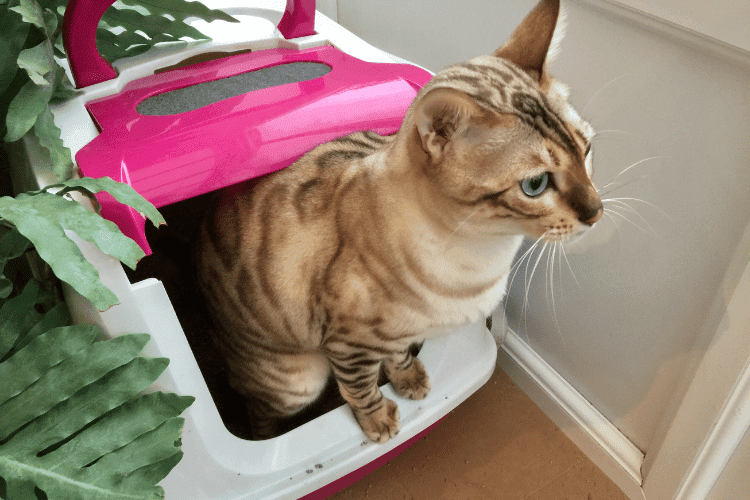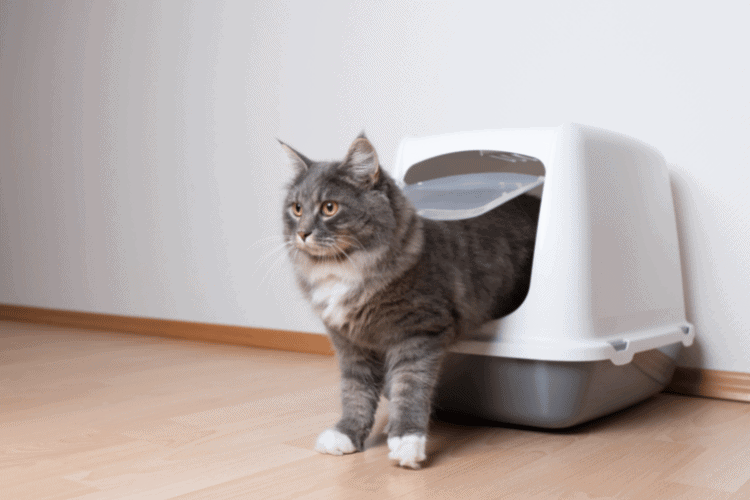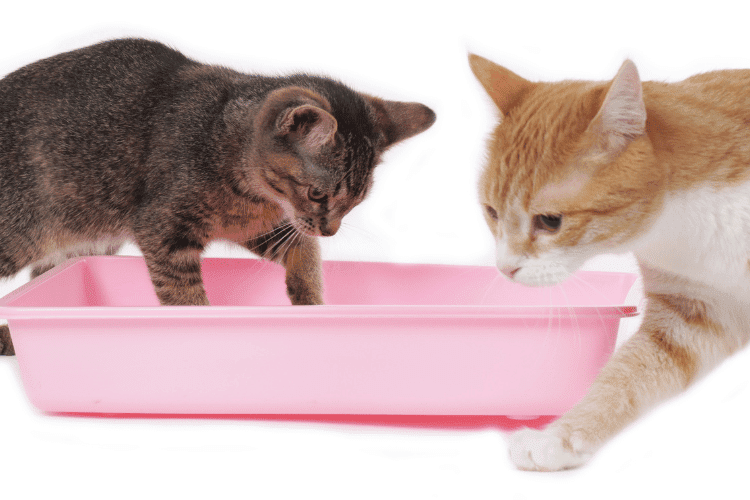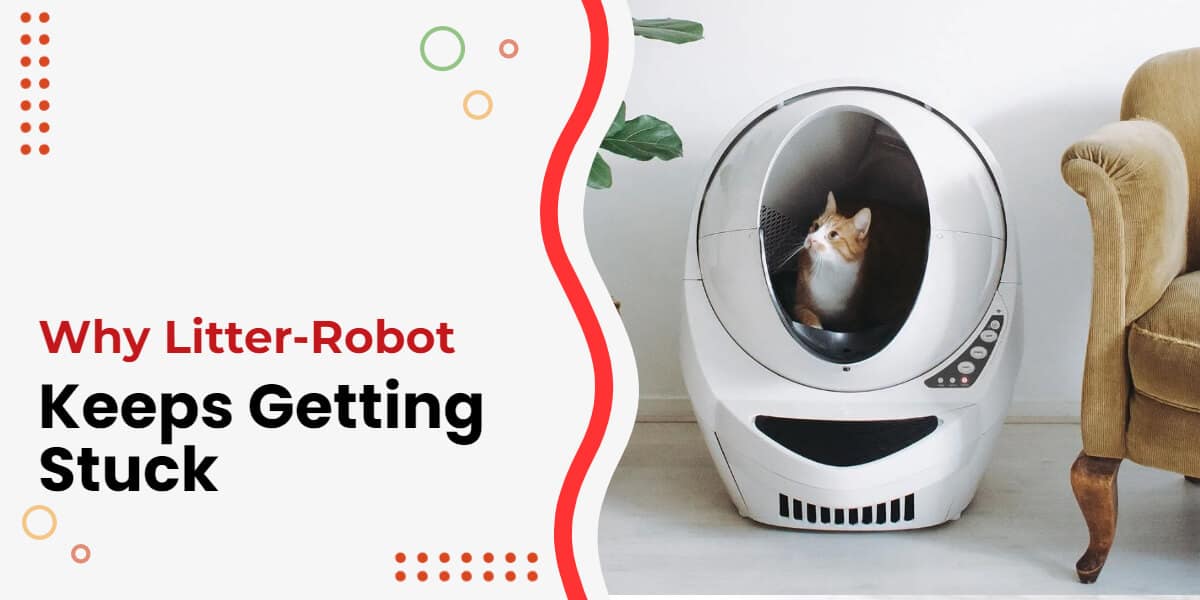The Litter-Robot is a nifty automatic litter box. While it’s truly a better alternative to using your hands and a scooper, you have to keep in mind that it’s still a machine. And that means it’s prone to experience technical difficulties at some point.
In this article, we’ll look at why the Litter-Robot keeps getting stuck and list down some possible solutions.

Table of Contents
What Is Causing Litter-Robot to Get Stuck?
Getting stuck or interrupted mid-cycle can be due to a few different reasons, including loose bonnets, faulty Cat Sensors, and dirty Anti-Pinch Sensors. Some of the possible solutions include resetting, checking for loose parts, checking the lights, and recalibrating the sensors.
Why Your Litter-Robot Keeps Getting Stuck and How to Solve It
All Litter-Robots are programmed to run a cleaning cycle each time a cat exits the Globe. However, sometimes you may find yourself faced with a stuck machine mid-cycle.
Let’s dig deeper into this problem and go over some of the possible actions you can take to find a solution to this issue.
1. Soft Reset Your Litter-Robot
There’s a reason turning it off and on is almost always the first step any customer service agent asks you to take. It resets any action the Litter-Robot is set to do and hopefully allows it to return to its Home position. You can also press the machine’s Reset button after turning the unit back on.
2. Do a Hard Reset
If a simple reset doesn’t quite do the job, you can try to perform a hard reset. Note that you can only do this if the Globe is at its Home position.
All you have to do is press and hold the Cycle button for five seconds and wait for the blue and yellow light to turn on. Then, press and hold the Cycle button again for five more seconds until only the blue light remains.
The next step is to activate the Cat Sensors by simulating your cat entering the Globe—press above the entrance. Lastly, press the Reset button and let the Litter-Robot complete its reboot.
3. Take a Closer Look at the Bonnet, Globe, and Base
Check the parts of your Litter-Robot and ensure none of them are loose. The cleaning cycle won’t work unless all the parts—especially the bonnet—are secured. A slow flashing yellow light may indicate that your bonnet has come loose.
You can manually disassemble and reassemble these parts to check if there’s any obstruction messing with them. It’s not uncommon to see clumps of litter or dirt and dust getting stuck between the crevices of the machine.

Related: Litter-robot vs. Catlink full comparison
Another thing to note is that you should never place your Litter-Robot on an uneven surface. The Base must be on a flat surface and should not be leaning to either side.
4. Check the Lights
Your Litter-Robot’s lights are very useful in telling you what the problem might be. Make it a habit to check them often when issues arise. Normally, if there are no issues, you’d see solid lights and no flashing.
5. Recalibrate Your Sensors
Your Litter-Robot also has a dedicated Reset button to reboot your Cat Sensors. This is especially useful after refilling the litter or cleaning the Waste Drawer. Remember, any weight changes can possibly mess with these sensors.
You can manually adjust them as well by following the steps below.
- Switch off your Litter-Robot.
- Remove the Globe and switch the power on.
- Observe if the gears are turning.
- If the gears are turning normally, turn off the unit again.
- Look at the bottom of the Base and locate the Adjustment Foot.
- Fully turn the foot clockwise two times.
- Put the Globe back on the Base and switch the unit back on.
The machine should be able to complete a full cleaning cycle without getting stuck. Note that if you don’t see any gears turning at all in Step 3, you have to contact your manufacturer.
6. Contact Your Litter-Robot’s Manufacturer
If the problem persists even after performing all of the steps above, it might be a good idea to turn to the manufacturers for help. The underlying issue might be beyond your ability to troubleshoot by yourself, such as wiring problems and defective motors.
Related: “Dump Position Fault” fixing in Litter-Robot
Tips to Keep Your Litter-Robot Working Like New
Below are some of the steps you can take to keep your Litter-Robot working—and hopefully, smelling—like new. Doing so also prevents several issues, such as the machine getting stuck mid-cycle. As they say, prevention is better than cure.
1. Clean It Regularly
Since clumps of litter can get stuck in the crevices of the Litter-Robot, it’s a good idea to clean it regularly. The manufacturer recommends giving your machine a good clean every one to three months and a deep clean at least three times a year.
You can use pet-friendly wipes to clean all surfaces of the machine. Just remember to be careful not to get the wirings wet. You should also disassemble the major parts, such as the Globe and Bonnet, to make sure no litter, dirt, or dust obstructs its tabs.
Remember to regularly change your liners for the waste drawer as well. Even if the Litter-Robot tries its best to eliminate odors, leaving a Waste Drawer filled up for too long can still stink up the place.
Users Also Read: The best litter box alternatives for your furry friend
2. Check Your Whisker App
The Litter-Robot comes with a Whisker App. You can download this on your mobile phone for notifications on status updates, Waste Drawer alerts, and even your cat’s usage stats.

This helps ensure that you clean out your Waste Drawer once it fills up and you refill the litter once it runs out.
3. Use Good Quality Clumping Cat Litter
While the Litter-Robot isn’t super particular with the brand of litter you need to use, it does highly recommend using low-dust, unscented, all-natural clumping litter.
Although, you don’t have to worry too much about constantly changing the litter often. The Litter-Robot’s mechanism only scoops out soiled litter, saving the clean parts.

